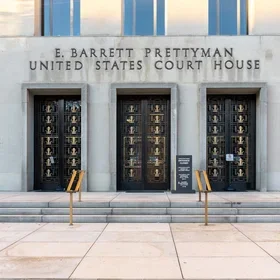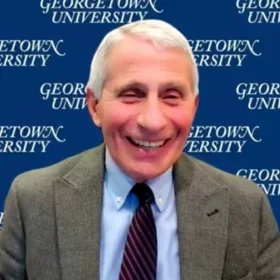By Steven Cohen, Ph.D., Director of the M.S. in Sustainability Management program, School of Professional Studies
Freezing payments to hospitals, firing thousands of AID workers, flying chained immigrants in military transports to Latin America, televised ICE raids, tariffs on our Mexican and Canadian friends planned, delayed, then imposed on steel and aluminum, dismantling EPA, offering staff illegal buyouts, Gaza as the Rivera, firing FBI and CIA agents, reducing overhead rates for scientific research and of course, taking over the Kennedy Center. The governing strategy out of Washington seems to be performative disruption at a ferocious pace. For those of us working in environmental sustainability, it has been a predictable and, as usual, fact-free period of Trump-led bombast and destruction.
The idea of a heavily government-subsidized transition to a renewable resource-based American economy was a progressive dream that never came true. Despite President Trump’s executive order ending the Green New Deal, there never was a Green New Deal. That does not mean the transition to renewable energy is not underway, it just means that most of the capital directed to that transition is private with the goal of making money. This is a good thing. In this country, subsidized businesses before Trump tended to work best in social services, health, and education. Consumer products always need to be proven in the private marketplace if they are to survive. The electric vehicle will eventually replace the internal combustion engine-powered vehicle. It is simply a superior technology that is constantly getting better. This is well underway in China and will eventually happen all over the world.
This brings me to publicly subsidized charging stations on interstate highways. While some interstate highways, like the New York State Thruway, are funded by users through tolls, most are free and subsidized by taxpayers. The rest stops on these highways are a mix of public and private operations. States like New York own the rest stops but rent space to private businesses. In many places, the service areas and truck stops are purely private operations located by highway exit ramps. To accelerate the visible placement of charging stations, Congress allocated funding to subsidize these stations. According to the Washington Post’s Shannon Osaka and Jake Spring:
“The program, which Congress approved under the Bipartisan Infrastructure Law, is known as the National Electric Vehicle Infrastructure program. It was intended to help fill gaps in the nation’s EV charging network and boost consumer confidence to buy electric vehicles. The law also provided another $2.5 billion for chargers in communities and neighborhoods. States had to submit plans to the Transportation Department on how they would use the funds; once their plans were approved, they could begin building out stations. To date, approximately $3.3 billion has been allocated to states…”
Last Thursday, the Federal Highway Administration froze the program. The Post article tries to make the point that this will further harm already struggling American electric vehicle manufacturers, but that’s debatable. Most EV owners charge at home. The absence of subsidized charging stations in lower-income urban neighborhoods is a setback, but once EVs take off, private charging stations will become available wherever the market requires them. On the road, there are a growing number of private companies such as Tesla, ChargePoint, and Electrify America offering charging services. Visible charging stations on interstate rest stops would inspire confidence and reduce “range anxiety,” but their absence is far from fatal. Of course, ending the grant program and freezing funds from grants already made to states is politically idiotic and clearly illegal. My guess is that the freeze won’t last, but like lots of action in Washington these days, it is performative and disruptive.
Far more troubling than the charging station freeze is the freeze on funding for scientific research and the reduction in overhead rates needed to fund science in universities. Elon Musk and his tech bros are trying to bring his Twitter-type destruction to federal spending. It’s one thing to diminish a major social media platform, it’s quite another to destroy the nation’s scientific research capacity. America’s research labs have long been a key asset in the technological competition that has spurred our economic growth. Government funding created the internet, microchips, smartphones, GPS, and too many medical breakthroughs to name. While the Trump team works to dismantle America’s research edge, the Chinese government is continuing to invest in science and technology and consumer goods like electric vehicles. While some of the freezes are clearly temporary, the overall impact on the scientific community has already been profound. In a disturbing piece in the Washington Post last week, Joel Achenbach and Carolyn Y. Johnson observed that:
“Scientists knew change was coming under President Donald Trump, but they were not remotely prepared for the chaos, confusion and fear incited by executive orders that have destabilized the world’s largest engine for innovation and discovery. Small-scale turbulence is manageable in the nation’s laboratories and academic institutions, but researchers trying to navigate unprecedented policy changes are whispering existential doubts… The first weeks of the Trump administration have been dizzying for scientists in government agencies and laboratories across the country where federal dollars keep experiments running. One of Trump’s first orders demanded an end to all government spending on diversity, equity and inclusion (DEI). Another said federal employees must use the word “sex” rather than “gender” and forbade federal spending on “gender ideology.”… As they await more clarity, many scientists are being told to move forward with existing projects. But the uncertainty in the nation’s laboratories is pervasive, with scientists unsure whether the work they do will remain funded, free of political interference and published without censorship… The state of play has changed not daily but hourly, as administration edicts have been rescinded or halted by judicial orders. At one point, scientists at the National Institutes of Health campus in Bethesda, Maryland, were told they couldn’t purchase critical lab supplies to keep their experiments running. A few days later, they could — though scientists report it’s an onerous, clunky process.
Public and private research universities throughout the United States are examining their exposure to potential federal cutbacks, a process that is damaging those universities and especially their medical, engineering, and basic scientific research labs. The long-term damage to our research institutions could be profound, and unlike charging stations, some forms of basic scientific research are too far removed from profit to generate private funds. It is the case that private funding for science is growing, particularly in fields like computer and pharmaceutical science. This includes funds for basic science. According to the National Science Foundation’s National Center for Science and Engineering Statistics:
“Funding for U.S. domestic research and development (R&D) performance, estimated to reach $885.6 billion in 2022, comes from a number of sectors, including businesses, government, higher education, and nonprofit organizations. The National Patterns of R&D Resources (National Patterns) publication series compiles data from surveys of organizations that perform R&D and documents trends in U.S. R&D funding and performance. In the 1980s, the business sector passed the federal government as the largest overall funder of domestic R&D performance. The most recent National Patterns publication made it clear that a similar milestone is approaching with respect to funding of basic research. At the turn of the century, the federal government funded about 60% of basic research. In 2022, the federal government is estimated to fund 40% of basic research… (As the share of federal funding for basic research has decreased, the share funded by business has increased. National Patterns estimates show that in 2022 40% and 37% of basic research is funded by the federal government and businesses, respectively.
Federal funds tend to focus on basic research that cannot attract private investment. The growth of private research funding is due to the growing role of medical, computer, and communications technology in the modern economy. Both forms of investment are vital to the national interest, and disrupting science is destructive and inexplicable. Basic research funded by government often finds a commercial application down the road. Perhaps you’ve heard of the internet. That began as a government project to share data among government computers.
Freezing all federal funding, even for a short period of time, is enormously disruptive, as is ending all AID programs and laying off thousands of workers involved in this work. I know that some AID programs are ill-advised, but simply ending all of them will cause preventable death and destruction. Not only is this causing enormous suffering all over the world, but as these workers return home and re-enter the economy, there is bound to be an increase in unemployment. In fact, even the temporary freeze on federal grants could upset the nation’s economy in ways that cannot help but be destructive. This anti-government strategy to disrupt the functioning of the federal government is at the heart of the Project 2025 playbook, disavowed but now implemented by President Donald Trump. There is little question that the federal government has grown less nimble, more bureaucratic, and overly infused with internal and external interest groups. Disruption can play a role in improving organizational performance, but here it looks more like an end itself, instead of a means to create greater cost-effectiveness in government. An effective strategy needs to analyze all projected impacts—both positive and negative. I see no analysis in DOGE’s work. Productive reform would have been better advised to follow the Clinton-Gore strategy of surgically reinventing government, instead of the ignorant, illegal, and ill-advised sledgehammer now being wielded by Trump, Musk, and his band of tech bros.
Rapid disruption of federal funding will have a non-trivial impact on the economy. While tax cuts could prime the economic pump, tariffs—or what is essentially a regressive national sales tax—would increase prices and reignite inflation. A rapid and unpredictable massive decline in federal expenditures could lead to contractor bankruptcies, reduce confidence in the economy, reduce investment and lead to a recession. President Trump has once again commanded the central stage of attention he craves. Unlike 2017, he has a plan, however narrowly framed, to disrupt and dismantle critical elements of the federal government. Only Congress and the courts have the authority to curb these actions, and it is unclear whether they will do so. An incapable and demoralized federal workforce would have an unpredictable impact on American prosperity and well-being. Under conditions of organizational uncertainty, the people who leave the organization are those who are best able to attract employment. Those who remain tend to be those who do not have the value in the employment market to get out. The result is a smaller and less capable government. If that is the goal of this strategy of disruption, it may well be within reach.
Views and opinions expressed here are those of the authors, and do not necessarily reflect the official position of Columbia School of Professional Studies or Columbia University.
About the Program
The Columbia University M.S. in Sustainability Management program offered by the School of Professional Studies in partnership with the Climate School provides students cutting-edge policy and management tools they can use to help public and private organizations and governments address environmental impacts and risks, pollution control, and remediation to achieve sustainability. The program is customized for working professionals and is offered as both a full- and part-time course of study.



